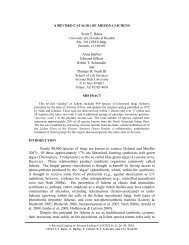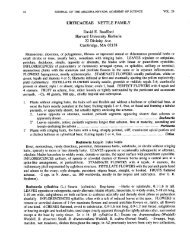A Preliminary Checklist of Arizona Macrofungi - Canotia
A Preliminary Checklist of Arizona Macrofungi - Canotia
A Preliminary Checklist of Arizona Macrofungi - Canotia
Create successful ePaper yourself
Turn your PDF publications into a flip-book with our unique Google optimized e-Paper software.
48 CANOTIA Vol. 2 (2) 2006<br />
include well-known groups that have been described by popular terms such as ‘cup<br />
fungi’, ‘bracket fungi’, ‘mushrooms’, ‘puffballs’, and ‘truffles’. These terms reflect<br />
the morphological diversity (Figs. 1 & 2) that is encountered within the fungi.<br />
Overall, fungal organisms play important roles in the Earth’s ecosystems.<br />
Saprobic macr<strong>of</strong>ungi perform a critical function in carbon cycling by decomposing<br />
woody debris from the forest floor, thus making this source <strong>of</strong> carbon available to<br />
other organisms (Gilbertson & Bigelow 1998). Because their hyphae act as an<br />
interface for nutrient absorption between soil and vegetation, ectomycorrhizal fungi,<br />
which produce macroscopic fruiting bodies, are considered to be invaluable<br />
components <strong>of</strong> forest ecosystems (Read & Perez-Moreno 2003). Furthermore, it has<br />
been noted that hypogeous species <strong>of</strong> macr<strong>of</strong>ungi can be an important food source for<br />
fauna such as the tassel-eared squirrel, Sciurus aberti Woodhouse (States 1983).<br />
Although there is a perceived paucity <strong>of</strong> literature covering macr<strong>of</strong>ungi from<br />
the southwestern United States (Nishida et al. 1992), the tremendous efforts <strong>of</strong> field<br />
mycologists such as R.L. Gilbertson and J.S. States have left numerous records <strong>of</strong><br />
<strong>Arizona</strong> macr<strong>of</strong>ungi in publications and as herbarium specimens. Also <strong>of</strong> note are<br />
W.H. Long’s specimens in the U.S. National Fungus Collection and his pioneering<br />
studies in the gasteromycetes (e.g., Long 1941, Long 1944, Long & Stouffer 1948ab),<br />
which comprise the majority <strong>of</strong> records <strong>of</strong> macr<strong>of</strong>ungi known from <strong>Arizona</strong> prior<br />
to the 1950’s. More recently, there has been an ongoing diversity study <strong>of</strong> the<br />
myc<strong>of</strong>lora found in the ‘Sky Islands’ <strong>of</strong> southern <strong>Arizona</strong>’s Chiricahua Mountains<br />
(Nishida et al. 1992). Considering that approximately 5% <strong>of</strong> the Earth’s fungal<br />
species have been described (Hawksworth 2001), it is probable that additional species<br />
<strong>of</strong> macr<strong>of</strong>ungi await discovery in <strong>Arizona</strong>. Indeed, several new species from the state<br />
have been recognized and now await formal description (Bessette et al. 2000, Tulloss<br />
2005).<br />
METHODS<br />
The species <strong>of</strong> macr<strong>of</strong>ungi cited in this paper have been culled from a survey<br />
<strong>of</strong> the scientific literature. Additional state records were obtained by searching<br />
herbarium databases that are available online through the New York Botanical<br />
Garden (NY, http://sciweb.nybg.org/science2/hcol/fungi/index.asp), Oregon State<br />
University Herbarium (OSC, http://ocid.nacse.org/research/herbarium/myco/),<br />
University <strong>of</strong> Michigan Fungus Collection (MICH, http://herbarium.lsa.umich.edu/),<br />
University <strong>of</strong> Tennessee Herbarium (TENN, http://tenn.bio.utk.edu/fungus/), and the<br />
U.S. National Fungus Collections (BPI, http://www.ars.usda.gov/main/). It should<br />
also be noted that many <strong>of</strong> the species cited from the literature are also deposited as<br />
specimens in herbaria (e.g., Gilbertson et al. 1974, Gilbertson & Bigelow 1998,<br />
Gilbertson & Ryvarden 1986-1987, Long & Stouffer 1948a-b, Nishida et al. 1992,<br />
States 1984, Thiers 1976). Data from the literature and herbarium databases were<br />
supplemented by records acquired from the author’s personal herbarium (hb. STB)<br />
and from the University <strong>of</strong> <strong>Arizona</strong>’s Robert L. Gilbertson Mycological Herbarium<br />
(ARIZ) after a physical search <strong>of</strong> specimens housed there.




